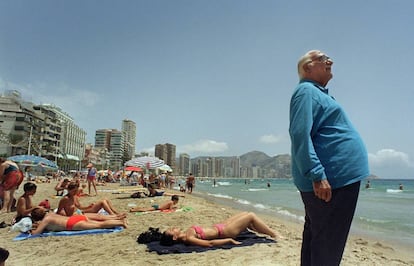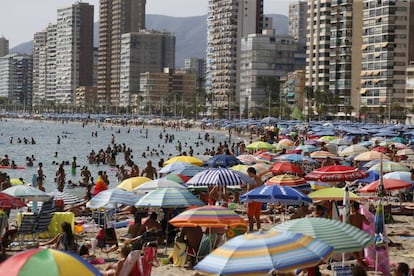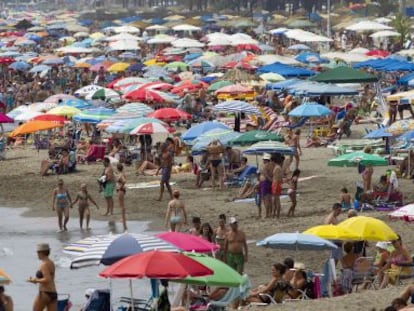Benidorm, or The Man who Bottled the Sun
A new documentary explores one man’s wildly successful plans for a tourist paradise in 1950s Spain

He turned a small, sleepy fishing village on the Valencian coast into a hotspot for hordes of tourists seeking fun in the sun. Pedro Zaragoza, the mayor of Benidorm from 1951 to 1967, was an intelligent, overpowering figure who was fond of excess. And it was he who designed a city for the middle-class tourist revolution that was about to sweep the European continent.

A documentary now explores his legacy, underscoring his achievements and evidencing the falsehoods behind some of the urban legends that Zaragoza himself liked to fuel.
Zaragoza was friends with the family of Spanish dictator Francisco Franco; the dictator’s wife, Carmen Polo, even stayed at his house. But long before that, he had wisely deduced that Spain’s need for foreign investment would lead the regime to open up to tourism, despite the threat of outside influence on the straitlaced Spanish society.
He gave away wine bottles with a shining sun on the label to hundreds of celebrities
And he envisioned that the Spanish government would eventually accept shocking items such as the bikini, which he unilaterally allowed on Benidorm’s beaches beginning in 1952.
As for the raw material, it was already there – pristine beaches on a virtually undeveloped Mediterranean coastline.
The documentary El hombre que embotelló el sol (or, The man who bottled the Sun), directed by Óscar Bernácer and produced by Jordi Llorca, does not paint the picture of a visionary.
Instead, Zaragoza emerges as a man who was shrewd enough to detect the area’s great potential just at the right time – when the newly created welfare state was giving workers paid vacation time, and tour operators were offering foreigners easy access to southern Europe.

Those were years when tourists were, quite literally, knocking on the doors of Benidorm. In the early 1950s there were barely a couple of hotels and the odd B&B in town. Visitors were desperately asking locals to rent them a room.
The mayor jumped on that demand, planning a city for tens of thousands of tourists at a time when the local registered population was just under 3,000.
Pedro Zaragoza opted for a vertical, hotel-heavy style of building. The documentary recreates a scene in which the Catalan architect Juan Guardiola allegedly suggested three different ways in which the new city could be built, using a cigarette packet as a model, and finally went for the one that made the most of the available space.
Lapping it up
Using testimony from tourism experts, hotel managers, city planners, historians, sociologists, former city employees and relatives, the filmmakers show how Benidorm was also innovative in the way it was promoted abroad.
At a time when tourism campaigns were conducted chiefly by the Spanish government for domestic consumption, Zaragoza plastered Germany with posters indicating the distance in kilometers to Benidorm.
The traveling mayor also made headlines in northern European papers when he went to pick up a family from Lapland, and brought them to the Mediterranean for a stroll on the beach in their traditional outfits.
Zaragoza planned a city for tens of thousands of tourists at a time when the local population was just under 3,000
Zaragoza placed almond tree branches with blooming flowers in the store windows of Scandinavian capitals in the dead of winter. And he gave away wine bottles with a shining sun on the label to hundreds of celebrities across the continent, including Queen Elizabeth II.
But the mayor also focused his ingenuity on attracting a budding domestic demand for sun-and-sand destinations. He once paid upfront for the honeymoon of 60 newlyweds from the rainy Basque Country – and Basques soon began buying Benidorm holiday homes in droves.
And taking a page out of Italy’s book, he created the Benidorm Festival, a celebration of easy listening that soon became a springboard for singers like Julio Iglesias or Raphael.
Reality and fiction
Zaragoza, who passed away in 2008, would often tell the story of how he once traveled to Franco’s residence in Madrid on his Vespa scooter to convince the dictator that female European tourists should be allowed to wear bikinis in Benidorm. But the documentary shows that there are no official records of any visit by Zaragoza to El Pardo Palace.
The mayor also liked to boast that the archbishop of Valencia excommunicated him for allowing the two-piece bathing suit on his beaches, yet there are no records of that, either.
Nor is there any evidence that he issued a local decree allowing the practice. Instead, all the testimony suggests that Zaragoza, ever the pragmatist, simply asked the local police to look the other way.
English version by Susana Urra.
More information









































